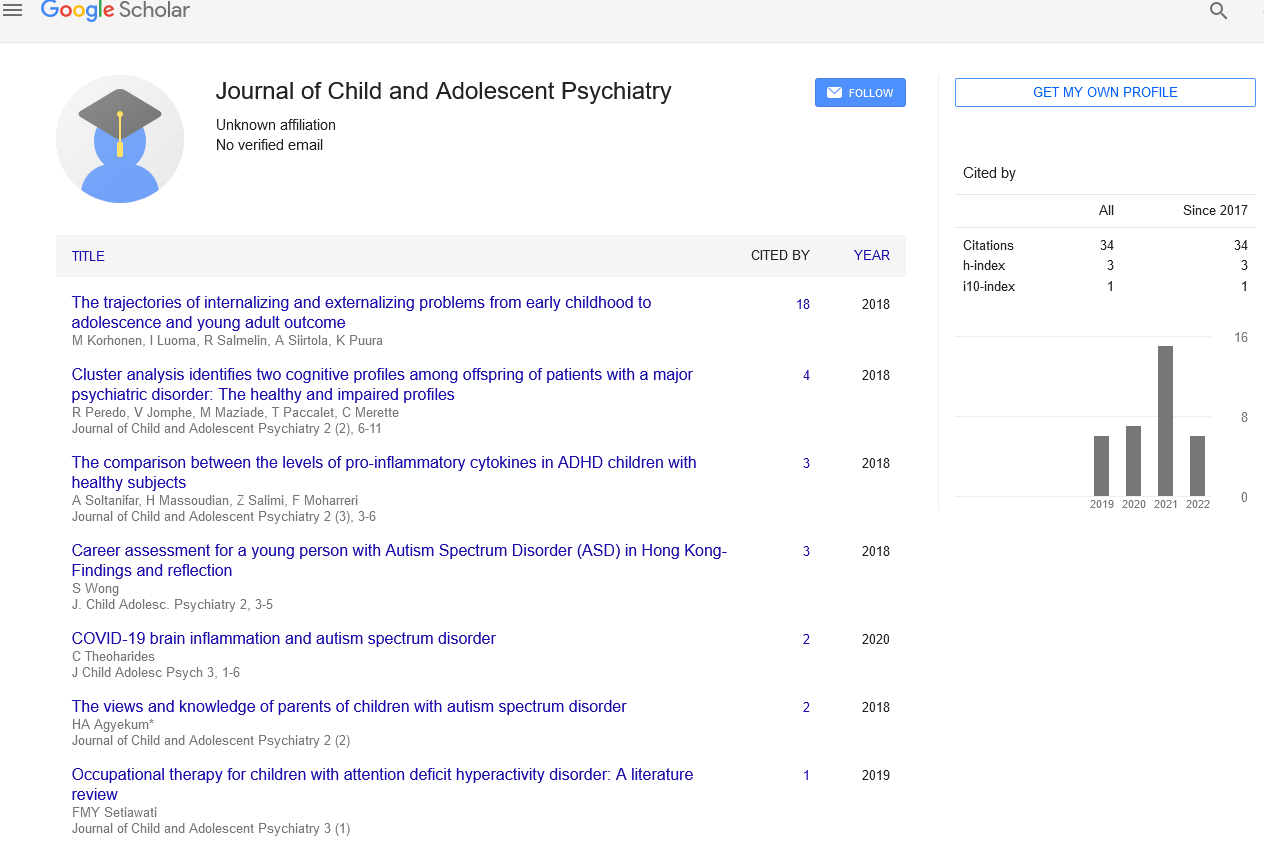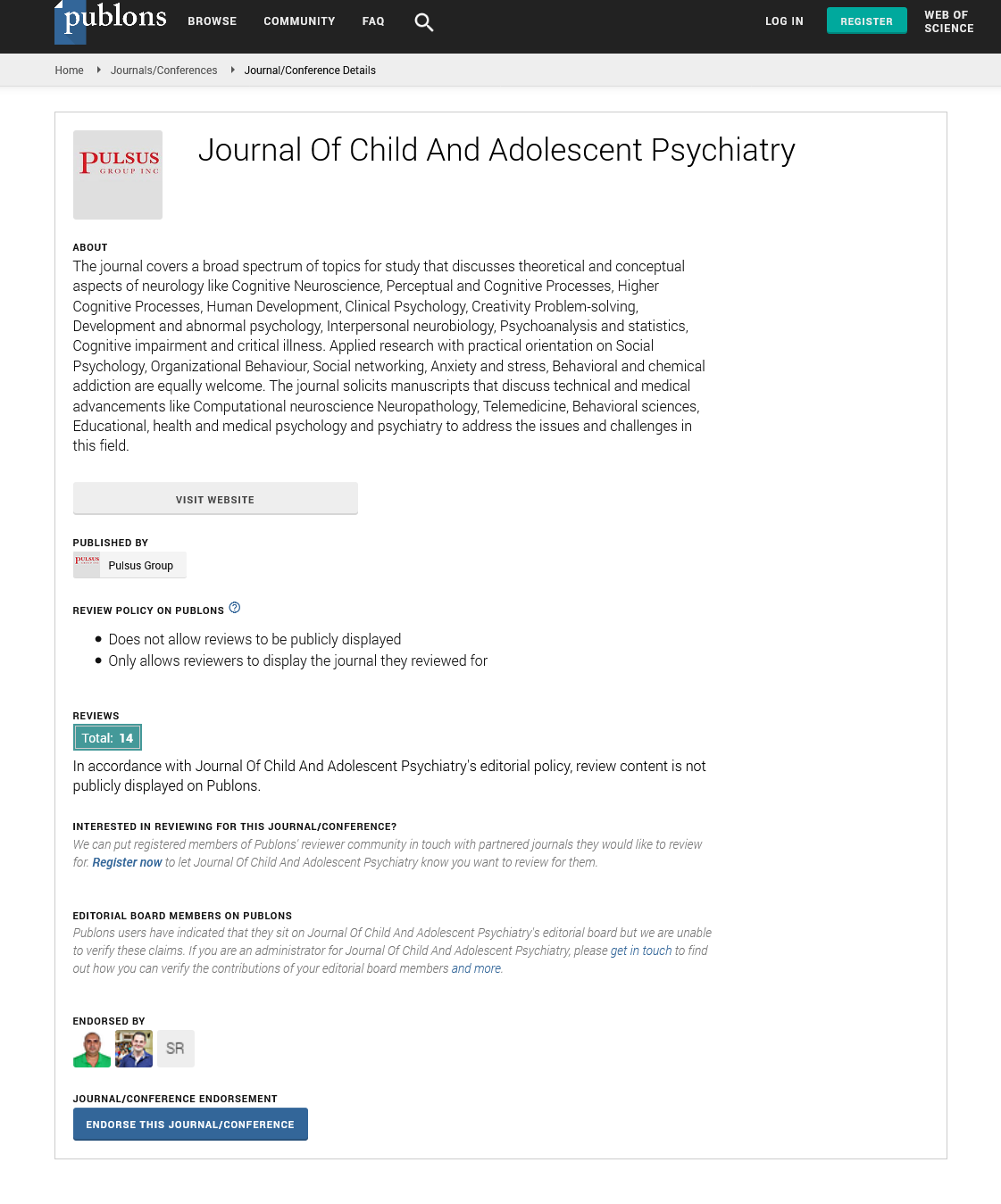ADVERSE CHILDHOOD EXPERIENCES
Received: 04-Mar-2023, Manuscript No. PULJCAP-22-5936; Editor assigned: 12-Mar-2023, Pre QC No. PULJCAP-22-5936(PQ); Reviewed: 16-Mar-2023 QC No. PULJCAP-22-5936(Q); Revised: 27-Mar-2023, Manuscript No. PULJCAP-22-5936; Published: 30-Mar-2023, DOI: 10.37532/puljcap. 2023.7(1);01-02
This open-access article is distributed under the terms of the Creative Commons Attribution Non-Commercial License (CC BY-NC) (http://creativecommons.org/licenses/by-nc/4.0/), which permits reuse, distribution and reproduction of the article, provided that the original work is properly cited and the reuse is restricted to noncommercial purposes. For commercial reuse, contact reprints@pulsus.com
Abstract
Early-life patients who need inpatient psychiatric care are a particularly vulnerable group. However, there is little research on factors such Adverse Childhood Experiences (ACEs) among those who need psychiatric inpatient care during childhood or adolescence and adulthood. Therefore, the current study's goal was to look at ACEs in young adult inpatients who had previously been admitted to Child and Adolescent Psychiatry
Key Words
Functional motion disorders; Neurodevelopmental
Introduction
Early-life patients who need Psychiatric Inpatient Treatment (PIT) appear to be an especially at-risk population, with higher rates of comorbidity, chronic mental disorders, and suicide. A major impairment caused by either a serious mental disorder or healththreatening psychosocial or trauma-related problems is generally considered to be indicated by psychiatric inpatient therapy. It is more restrictive than other sorts of care and is typically used when other forms of therapy have failed or when one's own or others' safety is in danger. Additionally, even for patients of a young age, it is by far the most expensive kind of care, requiring up to 90% of the mental health budget (e.g., US $3.5 billion annually). Adverse Childhood Experiences (ACEs) have been recognized to have a significant role in recent years, according to a wealth of literature examining risk factors for mental disorders. There are, however, few studies that look at ACEs and even fewer that examine risk factors for psychiatric inpatient treatment and its recurrence at a young age. Negative early experiences in the psychosocial environment are known as ACEs, and they include the primary categories of child abuse, neglect, and family breakdown such parental divorce, foster care, or parent loss. Its experience has been demonstrated to create an excessive activation of the stress response system, especially when it occurs over a longer period of time and in significant volumes.
It has been demonstrated that this so-called "toxic stress" has numerous detrimental impacts on a child's neuropsychological development as well as their metabolic, immunological, and cardiovascular systems. This is a pertinent explanation for the link between ACEs and unfavourable health outcomes. In general, it seems that there is a higher correlation between ACEs and mental illness and self-directed aggression than there is between ACEs and negative somatic health outcomes like obesity, cancer, or heart disease. It should be noted that biological sex is a significant element in suffering childhood trauma and unfavorable life experiences, as well as its trajectories, when describing influencing factors. In contrast to boys, girls are more likely to experience physical abuse than are boys.
There is proof that girls are more likely to experience a wider range of difficulties and are hence more vulnerable to mental illness. The tendency for females with ACEs to exhibit internalizing behaviors and the likelihood for males with ACEs to exhibit externalising behaviors is also stronger. ACEs are only connected to self-reported delinquency in boys, not girls, and depressive symptoms in adolescent girls, but not in boys. Women in both youth and adulthood are more likely to contact inpatient treatment when they are distressed.
Therefore, it is reasonable to assume that those who need psychiatric treatment early in life are more likely to be affected by ACEs and to be female because of the negative impact of ACEs on mental health and the less stable and supportive environment in which those affected from ACE often find themselves. As a result, individuals who were admitted to Child and Adolescent Psychiatry (CAP) had higher prevalence of ACEs and lower outcomes. In one study, it was discovered that nearly four times as many people with a history of child and adolescent psychiatric admissions (85%) reported having encountered at least one negative life event and had experienced ACEs (2.2 vs. 0.6) than healthy adolescents.
CAP in patients who suffer abuse have a greater risk of psychiatric comorbidity and longer hospitalizations, according to a retrospective chart analysis; however, the study excluded childhood familial adversity, with the exception of growing up with an adoptive parent or in custody. In a Finnish 1981 birth cohort research that followed up over 5,000 children, 6.2% of males and 4.1% of females who were later hospitalized as psychiatric inpatients between the ages of 13 and 24 were classified as childhood predictors of psychiatric inpatient treatment in adolescence and young adulthood. Self-reported depressed symptoms in a female 8-year-old, a non-intact family in a male 8-year-old and emotional and conduct issues in both male and female children were all significant predictors of psychiatric hospitalization.






